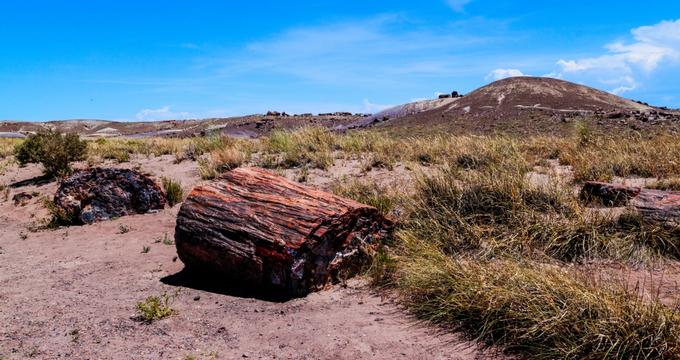Step into a world where ancient forests turned to stone and vibrant desert colors stretch across the horizon. Petrified Forest National Park in northeastern Arizona is a striking blend of natural beauty, geological wonder, and cultural history. Spanning over 230 square miles, this park invites visitors to explore fossilized trees from the Late Triassic Period, hike through colorful badlands, and connect with stories that span thousands of years.
Recommended For
This awe-inspiring desert park is perfect for:
- Geology and fossil enthusiasts—with ancient petrified wood and colorful sediment formations
- Hikers and outdoor explorers—offering scenic trails and backcountry adventures
- History and archaeology lovers—featuring petroglyphs, Pueblo ruins, and Indigenous history
- Families and photographers—with easy walks, dramatic landscapes, and unforgettable vistas
Overview & History
- Home to fossilized trees, plants, and animals from over 225 million years ago
- Part of the Chinle Formation, known for colorful mud, silt, and sandstone layers
- Lifted by tectonic forces, forming the Colorado Plateau with stunning erosion-carved features
- Humans have inhabited the area for more than 13,000 years
- Declared a national monument in 1906 and became a national park in 1962
Park Highlights & Attractions
- Painted Desert: A sweeping expanse of color-rich badlands with scenic viewpoints like:
- Chinde Point—picnic area with panoramic views
- Tawa Point—trailhead for Painted Desert Rim Trail
- Puerco Pueblo: 600-year-old Puebloan ruins with visible petroglyphs
- Newspaper Rock: Over 650 ancient petroglyphs etched into stone
- Jasper Forest: A dense area of massive petrified wood remains
- Rainbow Forest Museum: Exhibits of petrified wood and prehistoric fossils
- Painted Desert Inn: Historic adobe-style lodge and museum with Hopi murals
Hiking Trails
- Popular trails include:
- Blue Mesa Trail—a loop through blue-gray badlands
- Crystal Forest Trail—easy walk with glittering fossil wood
- Long Logs & Giant Logs—home to the park’s largest petrified trees
- Agate House Trail—leads to a Pueblo structure made of petrified wood
Wildlife & Climate
- Features over 447 plant species including more than 100 grasses
- Wildlife includes:
- Coyotes, bobcats, and pronghorns
- Jackrabbits and over 200 bird species
- Expect dry and windy conditions, with hot summers and cold winters
Outdoor Activities
- Self-guided hiking across marked trails and scenic overlooks
- Backpacking and horseback riding (with permits)
- Wilderness camping available via Kachina Point Trail access
Educational & Cultural Programs
- Seasonal ranger-led hikes and cultural demonstrations
- Petrified Forest Field Institute offers educational workshops and guided experiences
- Artist-in-residence program connects visitors with creative interpretations of the park
Visitor Information
- Headquarters: 28 miles east of Holbrook, AZ, via Interstate 40
- Painted Desert Visitor Center: Orientation film and exhibits
- Website: Petrified Forest National Park
Plan Your Trip


